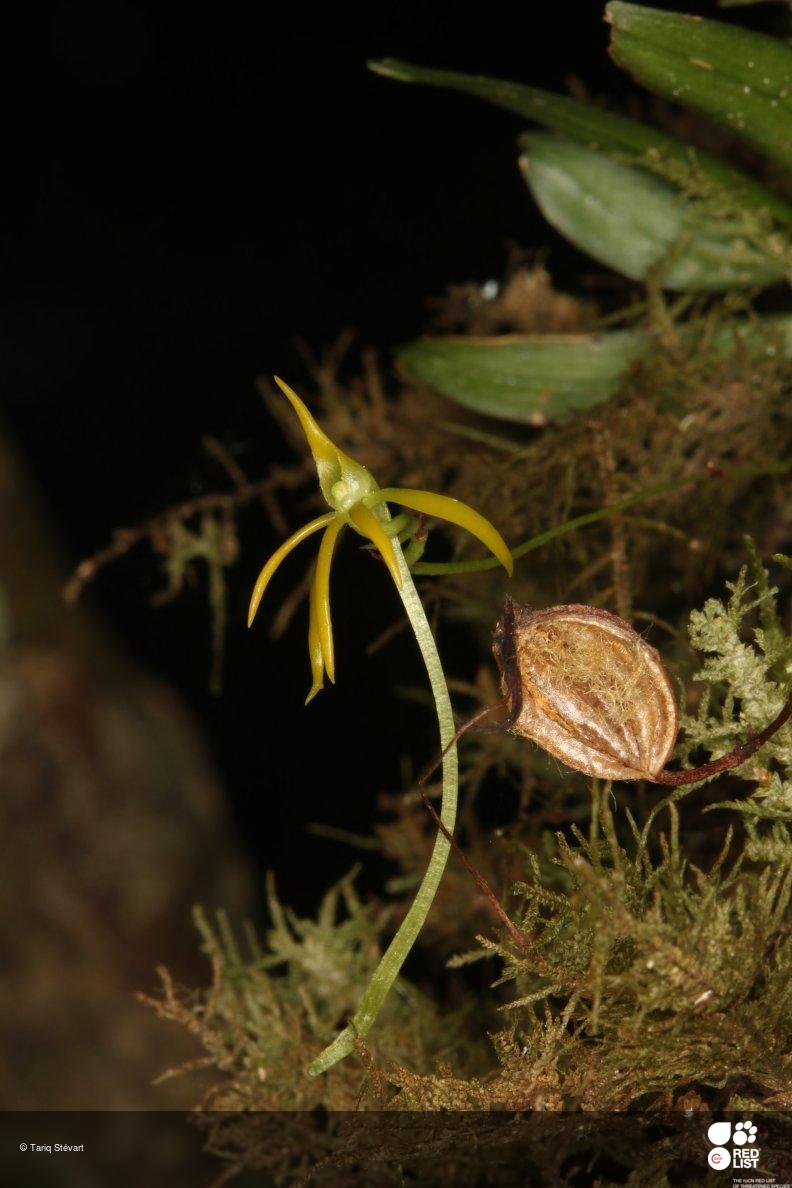Justification
Angraecum rhynchoglossum, is an epiphytic orchid endemic to Madagascar, in humid and subhumid forests, and mossy shrubland high-land between 15 to 1,544 m elevation. The species is known from 76 collections made between 1922 (Perrier 14973) and 2019 (Antananarivo Spirit Collection 589T319). The 76 collections represent 57 occurrences. Thirteen collections (12 occurrences) ) have been recorded in three protected areas, and are threatened by illegal logging. In addition to these officially protected sites, 23 collections representing 18 occurrences have been made in the Ambatovy footprint of a mining project undergoing intense human pressure such as forest clearing. These former occurrences must be considered as extirpated. However, the species has been collected from eight collections (eight occurrences) located in the areas under protection around the mine namely in the conservation zone surrounding the footprint (six occurrences), and in the CFAM : Analamay- Mantadia Forest Corridor (two occurrences). These forests should be subject to protection in the near future. It is also known from 32 collections (19 occurrences) made in unprotected forests subjected to selective logging, timber harvesting for small-scale subsistence, slash-and-burn agricultural practices (tavy), and fire for grazing. The species is thus known from 76 collections representing 39 existing and 18 extirpated occurrences.
The extent of occurrence (EOO) of A. rhynchoglossum is estimated to be 24,968 km2 (far exceeding the limits for Vulnerable status under criterion B1) whereas its area of occupancy (AOO) is estimated at 116 km2 (which falls within the limits for Endangered status under criterion B2). These 39 remaining occurrences represent a total of 14 locations (sensu IUCN 2022) with respect to the most serious plausible threat, slash-and-burn agricultural practice (tavy), exceeding the upper limit for Vulnerable status. We estimate that the past loss of its habitat, which will continue, has and will induce a strong continuous decline in habitat quality, number of subpopulations, and mature individuals in the next ten years as well as an important decline in its EOO and AOO. We also suspect an ongoing population reduction (number of subpopulations) of 50% (38 of the 76 occurrences), the ones occurring in Moramanga and surrounding, Analabe, Mandraka, Ankeramadinika, Talata-Volonondry, Tsinjoarivo, Vohitralongo for this species over 30 years period (three generations) in the past and the future, where the causes of reduction, forest clearing, will not cease and may not be reversible based on a decline in extent of occurrence, area of occupancy and habitat quality falling within the threshold for Endangered status. Since the threat level is higher under criterion A than criterion B, based on IUCN guidelines, the first criterion applies. Angraecum rhynchoglossum is therefore assigned a status of Endangered; EN A4(c).
Geographic Range Information
Angraecum rhynchoglossum, an epiphytic orchid endemic to Madagascar, is known from three Regions: Alaotra-Mangoro (Ambatovy, Analamazaotra), and Antsinanana (Vohibe-Ambalabe) in Toamasina Province, Analamanga (Analabe, Angavokely, Ankeramadinika, Mandraka, Mantasoa, Talata-Volonondry, Vohitralongo) and Vakinakaratra (Tsinjoarivo) in Antananarivo Province in humid and subhumid forests (Madagascar Catalogue 2022).
Population Information
The population of Angraecum rhynchoglossum is currently thought to be decreasing since its habitat is threatened by forest clearing due to mining activities, forest degradation by illegal logging, timber harvesting for small-scale subsistence use, and slash-and-burn agricultural practices (tavy). The number of individuals of A. rhynchoglossum is not known and cannot be estimated since the species is an epiphyte on the trunk or branches of trees in humid, subhumid forests, and mossy shrubland.
Habitat and Ecology Information
Angraecum rhynchoglossum is an epiphytic herb growing on the trunk and branches of trees on moss- and lichen-covering trees in humid and subhumid forests, and mossy shrubland high-land between 15 to 1,544 m elevation (Madagascar Catalogue 2022).
Threats Information
Angraecum rhynchoglossum is threatened by intense human pressure such as forest degradation ( slash-and-burn agricultural practices (tavy), selective logging, timber harvesting for small-scale subsistence, and fire for grazing), forest clearing (mining activities).
Use and Trade Information
There are no reported uses of the species, but it may be sought after by specialist collectors.
Conservation Actions Information
Twelve occurrences of the species are situated within four protected areas: Analamazaotra National Park, Natural Resources Reserve of the Ankeniheny-Zahamena Corridor (Vohibe-Ambalabe), and Pointe à Larrée Special Reserve. The species is also currently placed in Appendix II of CITES. Ex situ conservation is recommended (micro-propagation, and living collections). A. rhynchoglossum should be included in the list of Malagasy protected species. Further awareness building is recommended for local communities and national authorities.

